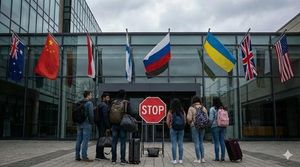As President Donald Trump’s second term progresses, the U.S. economy finds itself in a curious bind. On the surface, the numbers don’t quite add up—or at least, they don’t tell a straightforward story. According to The Business Times, traditional economic indicators are sounding alarms: inflation is on the rise, jobs are less secure, and consumers are growing anxious about their financial futures. Yet, in the midst of these warning signs, the nation’s gross domestic product (GDP) continues to show robust growth. What gives?
The answer, it turns out, lies in a technological juggernaut: artificial intelligence. The AI boom isn’t just a headline-grabber; it’s become the single most important force propping up economic expansion in the United States. Global AI spending is expected to reach a staggering $375 billion in 2025 and soar to $500 billion by 2026. In the first half of 2025 alone, AI-related capital expenditures contributed 1.1 percent to U.S. GDP growth, outpacing even the mighty American consumer as the primary engine of expansion. This unprecedented surge is masking deeper economic challenges, at least for now.
But beneath the surface, there’s a growing debate about the sustainability of this growth and the wisdom of the government’s economic interventions. President Trump, as reported by POLITICO on November 12, 2025, is carving out a new and controversial brand of capitalism. His approach combines extraordinary federal interventions—such as taking ownership stakes in private companies—with sweeping tariffs, tax cuts, and deregulation. Yet, critics argue that these moves are not part of any coherent strategy.
Economist Mariana Mazzucato, who leads the Institute for Innovation and Public Purpose at University College London, didn’t mince words in her interview with POLITICO Magazine. She described Trump’s economic policies as “an idiosyncratic hodgepodge.” In her view, “Trump is not asking, ‘What are the problems that need to be solved, and how can we have public investment to solve those problems?’ He’s just kind of throwing money around and imposing tariffs and taking these equity stakes and dismantling things.”
It’s a notable critique, especially coming from someone who has long advocated for robust government involvement in shaping industries. Mazzucato has argued that politicians should help citizens share in the benefits of public investment, for instance by taking equity in private-sector firms that receive government support. But she insists that such measures only make sense as part of a broader industrial strategy—a vision for what the country wants to achieve and how to get there. “You want a smart, capable state,” she said, “not just a big state or a small state.”
Trump’s interventions, such as the government’s 10 percent equity stake in Intel, may grab headlines, but Mazzucato contends that they lack meaningful direction. “He’s just taking a clawback measure without it being linked to the creation of value. So it’s just taking, not making. I think he’s doing it to show strength,” she told POLITICO. She warns that such moves, absent a holistic set of policies, do not amount to real industrial strategy. Instead, they risk weakening the very economic foundations that once enabled American innovation.
Historically, U.S. industrial policy has been most successful when the government played an active, strategic role in shaping investments. Mazzucato points to the birth of Silicon Valley as a prime example. Government investments in technologies like the internet, DARPA, GPS, and touchscreen displays weren’t just about spending money—they were about identifying challenges, setting ambitious goals, and mobilizing both public and private sectors to solve them. “All the technology that makes our smartphones smart and not stupid would never have happened without the state taking an active part of shaping investments,” Mazzucato explained.
But today, she argues, that kind of mission-driven approach is lacking. Instead of fostering new entrants and helping them scale, Trump’s policies are more about retroactively taking stakes in established companies. “A lot of these companies that he’s thinking about taking equity stakes in are not the fruit of any sort of investment that he has been part of. So, it’s kind of retroactive,” she observed. Without a clear agenda or outcome-oriented conditions, these interventions risk becoming little more than political theater.
The contrast with the previous administration is stark. The Biden administration’s CHIPS Act and Inflation Reduction Act were designed to stimulate U.S. production and competitiveness, but with strings attached. Companies receiving subsidies had to meet specific conditions—like limiting share buybacks and reinvesting profits—meant to ensure that public money led to real economic benefits. “There should be conditions like limiting the share buybacks,” Mazzucato noted. “If it’s wealth that’s created that the taxpayer funds, the least condition should be to reinvest back into the economy instead of extracting it out to the financial system.”
This difference in approach goes beyond mere policy details. Mazzucato warns that dismantling strategic public institutions—the backbone of U.S. competitiveness—could have dire long-term consequences. “What’s going to happen in the future is, U.S. competitiveness will wither away because he’s dismantling the backbone of U.S. competitiveness which has been, in the past, smart, capable, strategic, outcome-oriented, mission-oriented state agencies,” she cautioned.
Of course, not everyone sees it the same way. Supporters of Trump’s approach argue that his interventions, while unconventional, are necessary to restore American manufacturing and assert economic strength in a rapidly changing world. They point to the AI boom as evidence that the U.S. can still lead in cutting-edge industries, even if the path is unorthodox. But critics counter that without a clear, coordinated strategy, these gains may prove fleeting.
The debate also touches on deeper questions about the role of government in the economy. Is it enough to simply reshore manufacturing and hope for the best? Or does the U.S. need to be the place where the next wave of innovation happens—a country that attracts the world’s best companies and talent by offering a dynamic, supportive ecosystem? Mazzucato believes the answer is clear: “It’s not about reshoring manufacturing. It’s about making your country the coolest place to be for all of the world’s companies. That’s what Silicon Valley did.”
As the AI boom continues to mask underlying economic challenges, the real test for the U.S. economy may be whether it can move beyond ad hoc interventions and embrace the kind of smart, mission-driven strategy that has fueled its greatest successes. For now, the paradox persists: impressive growth numbers on paper, but a growing chorus of voices questioning what lies beneath.
The coming months will reveal whether America’s AI-powered expansion is built on solid ground—or just a high-tech mirage.




